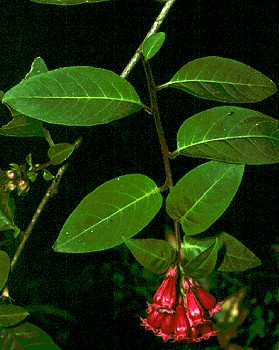 Branch with flowers (J.R. Hosking 1068 , Dandenong Ranges NP, Vic.) Photo: J.R. Hosking © J.R. Hosking |
 Inflorescence (J.R. Hosking 1068, Dandenong Ranges NP, Vic.) Photo: J.R. Hosking © J.R. Hosking |

Synonymy
*Cestrum elegans (Brongn. ex Neumann) Schldl., Linnaea 19: 261 (1846)
Habrothamnus elegans Brongn. ex Neumann, Ann. Pomone 118 (1844).
T: province d'Oaxaca [Mexico], M. Geisbreght; n.v.
Description
Woody shrub to 3 m, all parts pubescent.
Leaves broadly lanceolate; lamina 6–17 cm long, 2–9 cm wide, pubescent; petiole 10–30 mm long.
Inflorescence a congested, terminal panicle of subspicate racemes, densely pubescent with purple hairs; flowers numerous, sessile or on pedicels 0.5 mm long, the lower ones subtended by lanceolate, often coloured, bracts. Calyx 6–8 mm long; lobes triangular-acuminate, to 3 mm long. Corolla reddish; tube 15–20 mm long, 1–1.5 mm diam. at base, expanded to 5 mm at apex; lobes 2.5–4 mm long. Stamens inserted just below middle of corolla-tube; filaments 10 mm long, swollen and sparsely pubescent at base; anthers 1–1.5 mm long. Style c. 17 mm long.
Berry more or less globular, c. 10 mm diam., red. Seeds not known.
Distribution and ecology
Native of Mexico. At the time of the 1982 Flora of Australia treatment described as an uncommon garden escape in south-eastern Qld and southern Vic.
There are now records from other areas along the eastern Australian coastline, south of Brisbane and in the Sydney region.
Common name
Red cestrum
Notes
C. fasciculatum and C. elegans are similar in appearance, the usual difference being cited as C. fasciculatum having larger flowers. C. elegans also tends to have flowers which are in the "pink" range while C. fasciculatum flowers are usually described as being scarlet.
The outer surface of the calyx and corolla is also cited as being pubescent in C. fasciculatum but glabrous in C. elegans.
However C. fasciculatum cultivar "Newellii" (also as C. Newellii) is considered to be a hybrid between C. fasciculatum and C. elegans, most horticultural sources citing it as having glabrous corollas; true distinctions are unclear. This is probably why no distinction is made between C. fasciculatum and C. elegans on a New Zealand weed website at http://www.weedbusters.org.nz/weed_info/detail.asp?WeedID=83
Specimens seen in Australian herbaria are not consistent with respect to the hairiness of the calyx and corolla and so further investigation of these two species is needed before we can be sure just what is present in Australia [rmb Aug. 2006].
Selected specimens
Qld: Tamborine, 4 July 1962, S.L. Everist, J. Teys & P. Knowles (BRI). Vic.: Perrins Creek Road, Apr. 1977, A.M. Opie (MEL).
Derivation of epithet
From elegans, Latin for elegant or graceful.
Images and information on web
Images of C. elegans can be accessed through the Digital Flora of Texas and through http://www.plantsystematics.org/.
Information about this species and C. fasciculatum as weeds in in New Zealand can be seen on their Weedbusters site at http://weedbusters.co.nz/weed_info/detail.asp?WeedID=83
Further information about the toxic properties of this plant can be found with a search in the FDA Poisonous Plant Database